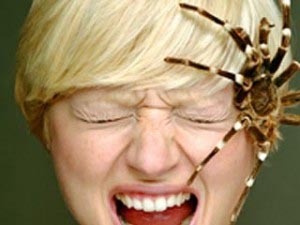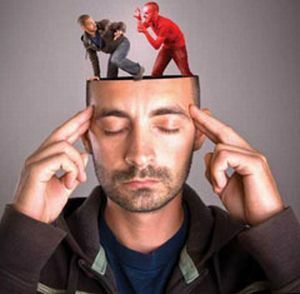 Obsessive neurosis is a mental disorder accompanied by anxiety, fear, anxiety and fear.
Obsessive neurosis is a mental disorder accompanied by anxiety, fear, anxiety and fear.
Obsessive states are doubts, thoughts and drives that appear in addition to the will of a person.
In turn, compulsive states cause obsessive-compulsive movements.
Contents
- Obsessive thoughts and movements neurosis
- Concomitant disorders
- Causes of the disorder
- Symptoms of the disease
- Phobias for obsessive neurosis
- Diagnosis
- How to help the neurotic?
- We will survive this unpleasantness, but with consequences?
Obsessive neurosis of thoughts and movements
Obsessive thoughts arise against the will of the person. He can not get rid of them on his own. The thought of an unlocked front door does not disappear even after a person has checked it 20 times. Obsessions are very diverse. As a rule, they are associated with fears and phobias. They are meaningless and interfere with a normal life.
Obsessive thoughts are specific and vague. Specific obsessions cause anxiety attacks, lead to personal deformity. 
Vague thoughts cause a person to be in constant anxiety, which is very exhausting and does not allow him to deal with everyday affairs. Patients may be troubled by thoughts about past events, about various misfortunes.
There is also a sexual obsession. As a result, the patient feels insecure, lonely and inferior.
Pathological thoughts cause a person to commit uncontrollable actions. Obsessions can be manifested in frequent blinking, twitching, spontaneous wiggle with the arm or leg. People are aware of obsessive movements, but they can not control them.
Concomitant disorders
Obsessive neurosis often causes other diseases:
- Bulimia nervosa is an eating disorder that is characterized by excessive, uncontrolled food intake.
- Anorexia nervosa is an eating disorder characterized by a refusal to eat. The patient can not stop even if his weight reaches 30-40 kilograms.
- Generalized and anxiety disorder is a mental disorder, accompanied by a persistent causeless state of anxiety.
The obsessive-compulsive disorder can also lead to addiction and alcoholism. Patients take psychotropic substances to at least temporarily cope with anxiety attacks.
The causes of the disorder
Until now, the causes of the disease remain unknown. There are only theoretical assumptions, not confirmed by research.
Biological reasons: 
- traumatic brain injury;
- heredity;
- deviations in the work of the vegetative-nervous system;
- metabolic disorders that ensure normal brain function and supply neurons;
- infectious diseases.
Socio-psychological causes:
- experienced stress;
- hard work in production;
- psycho-traumatic situations in early childhood;
- experienced a strong fear.
In 10-15% of patients, obsessive neurosis occurs during puberty when changes occur in the hormonal system.
Symptoms of the disease
The most vivid symptom of the obsessive neurosis is rituals. These are obsessive movements and actions, accompanied by doubts, fears and  fears.
fears.
In patients with neuroses decreased concentration of attention, they quickly become irritated, tired, sleep badly. They have an excess of negative emotions, a negative attitude, a pessimistic outlook on life, destructive thinking.
In children, neurosis has more vivid symptoms. A child experiencing severe anxiety can wriggle involuntarily, stamp feet, blink, nibble, suck hair, snap fingers, itch. This indicates that the nervous system has failed, and the child needs urgent medical attention.
Phobias in obsessive neurosis
In the clinical picture of the disease, the following types of phobias are most common:
- fear of sharp and pecking subjects;
- fear of open or enclosed space;
- fear of heights;
- fear of redness and pollution;
- fear for one's health: the fear of going insane, dying of a heart attack, etc.
As a rule, the patient immediately has several phobias.
Diagnosis of
The examination of the patient includes:
- anamnesis collection : the time of the onset of the first symptoms, the transferred infectious diseases, information about the living conditions;
- conversation with the family and close environment of the patient ;
- examination of the patient .
Despite the fact that obsessive neurosis has a pronounced symptomatology, psychiatrists also conduct differential diagnostics with diseases that have related symptoms: the early stage of schizophrenia, psychopathy.
How to help the neurotic?
Treatment of compulsive neurosis should be comprehensive. It includes psychotherapeutic sessions and medication. In severe cases, hospitalization is necessary.
In hospital conditions, patients adhere to a strict regime, followed by specialists around the clock.
Treatment stages:
- Admission antidepressants to suppress depressive state and tranquilizers - for correction of increased anxiety.
 In chronic forms, patients are assigned atypical psychotropic substances.
In chronic forms, patients are assigned atypical psychotropic substances. - Psychotherapy .It gives very good results, but only after the patient has been treated medically. The most popular method of psychotherapy, which treats various obsessions, is cognitive-behavioral therapy. The patient remains alone with his fears and feelings, which makes him struggle with them. He is placed in conditions where it is difficult to perform ritual actions. Over time, they are reduced to "no".Pass and obsessive thoughts.
Unfortunately, in very rare cases the patient is permanently cured of obtrusiveness. Even after a long remission they can return.
We will survive this unpleasantness, but with consequences?
Consequences of the obsessive neurosis:
- Decreased performance .This leads to a deterioration of mental abilities, a decrease in concentration of attention. Even after doing simple daily work a person gets tired. The situation is further aggravated by the fact that the patient can not restore strength even during the night's sleep, because it is also broken.
- Problems in dealing with people .Disease leads to the fact that a person becomes touchy, sentimental, anxious. These qualities very often cause conflicts, scandals and misunderstandings.
- The onset of internal diseases .Violations of the emotional sphere exhaust the body and reduce its protective functions. Patients often have infectious and catarrhal diseases that can disrupt the functioning of the liver, heart, kidneys, stomach, etc.



